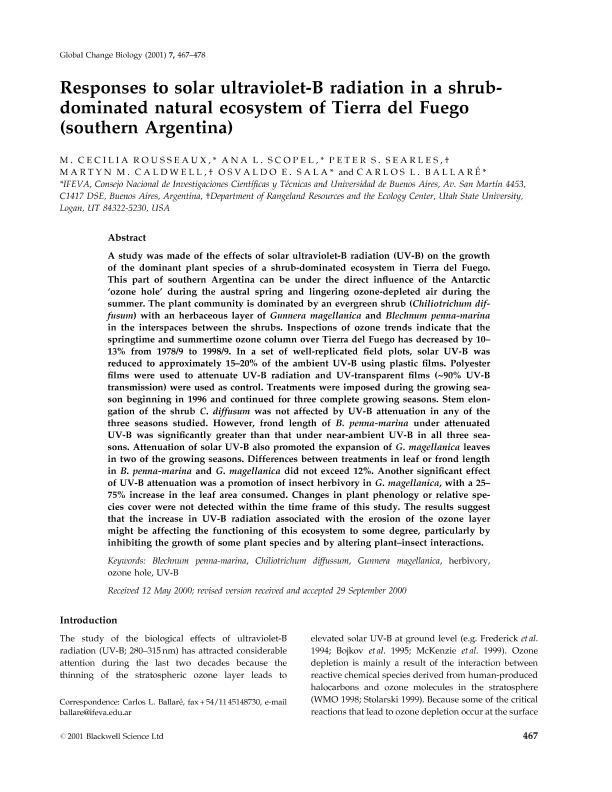Mostrar el registro sencillo del ítem
dc.contributor.author
Rousseaux, Maria Cecilia

dc.contributor.author
Scopel, Ana Leonor

dc.contributor.author
Searles, Peter Stoughton

dc.contributor.author
Caldwell, Martyn M.
dc.contributor.author
Sala, Osvaldo Esteban

dc.contributor.author
Ballare, Carlos Luis

dc.date.available
2019-03-15T19:30:29Z
dc.date.issued
2001-01
dc.identifier.citation
Rousseaux, Maria Cecilia; Scopel, Ana Leonor; Searles, Peter Stoughton; Caldwell, Martyn M.; Sala, Osvaldo Esteban; et al.; Responses to solar ultraviolet-B radiation in a shrub-dominated natural ecosystem of Tierra del Fuego (southern Argentina); Wiley Blackwell Publishing, Inc; Global Change Biology; 7; 4; 1-2001; 467-478
dc.identifier.issn
1354-1013
dc.identifier.uri
http://hdl.handle.net/11336/71781
dc.description.abstract
A study was made of the effects of solar ultraviolet-B radiation (UV-B) on the growth of the dominant plant species of a shrub-dominated ecosystem in Tierra del Fuego. This part of southern Argentina can be under the direct influence of the Antarctic 'ozone hole' during the austral spring and lingering ozone-depleted air during the summer. The plant community is dominated by an evergreen shrub (Chiliotrichum diffusum) with an herbaceous layer of Gunnera magellanica and Blechnum penna-marina in the interspaces between the shrubs. Inspections of ozone trends indicate that the springtime and summertime ozone column over Tierra del Fuego has decreased by 10-13% from 1978/9 to 1998/9. In a set of well-replicated field plots, solar UV-B was reduced to approximately 15-20% of the ambient UV-B using plastic films. Polyester films were used to attenuate UV-B radiation and UV-transparent films (∼90% UV-B transmission) were used as control. Treatments were imposed during the growing season beginning in 1996 and continued for three complete growing seasons. Stem elongation of the shrub C. diffusum was not affected by UV-B attenuation in any of the three seasons studied. However, frond length of B. penna-marina under attenuated UV-B was significantly greater than that under near-ambient UV-B in all three seasons. Attenuation of solar UV-B also promoted the expansion of G. magellanica leaves in two of the growing seasons. Differences between treatments in leaf or frond length in B. penna-marina and G. magellanica did not exceed 12%. Another significant effect of UV-B attenuation was a promotion of insect herbivory in G. magellanica, with a 25-75% increase in the leaf area consumed. Changes in plant phenology or relative species cover were not detected within the time frame of this study. The results suggest that the increase in UV-B radiation associated with the erosion of the ozone layer might be affecting the functioning of this ecosystem to some degree, particularly by inhibiting the growth of some plant species and by altering plant-insect interactions.
dc.format
application/pdf
dc.language.iso
eng
dc.publisher
Wiley Blackwell Publishing, Inc

dc.rights
info:eu-repo/semantics/openAccess
dc.rights.uri
https://creativecommons.org/licenses/by-nc-sa/2.5/ar/
dc.subject
Blechum Penna-Marina
dc.subject
Chiliotrichum Difussum
dc.subject
Gunnera Magellanica
dc.subject
Herbivory Ozone Hole
dc.subject
Uv-B
dc.subject.classification
Otras Ciencias Biológicas

dc.subject.classification
Ciencias Biológicas

dc.subject.classification
CIENCIAS NATURALES Y EXACTAS

dc.title
Responses to solar ultraviolet-B radiation in a shrub-dominated natural ecosystem of Tierra del Fuego (southern Argentina)
dc.type
info:eu-repo/semantics/article
dc.type
info:ar-repo/semantics/artículo
dc.type
info:eu-repo/semantics/publishedVersion
dc.date.updated
2019-03-14T14:19:09Z
dc.journal.volume
7
dc.journal.number
4
dc.journal.pagination
467-478
dc.journal.pais
Reino Unido

dc.journal.ciudad
Londres
dc.description.fil
Fil: Rousseaux, Maria Cecilia. Consejo Nacional de Investigaciones Científicas y Técnicas. Oficina de Coordinación Administrativa Parque Centenario. Instituto de Investigaciones Fisiológicas y Ecológicas Vinculadas a la Agricultura. Universidad de Buenos Aires. Facultad de Agronomía; Argentina
dc.description.fil
Fil: Scopel, Ana Leonor. Consejo Nacional de Investigaciones Científicas y Técnicas. Oficina de Coordinación Administrativa Parque Centenario. Instituto de Investigaciones Fisiológicas y Ecológicas Vinculadas a la Agricultura. Universidad de Buenos Aires. Facultad de Agronomía; Argentina
dc.description.fil
Fil: Searles, Peter Stoughton. State University of Utah; Estados Unidos
dc.description.fil
Fil: Caldwell, Martyn M.. State University of Utah; Estados Unidos
dc.description.fil
Fil: Sala, Osvaldo Esteban. Consejo Nacional de Investigaciones Científicas y Técnicas. Oficina de Coordinación Administrativa Parque Centenario. Instituto de Investigaciones Fisiológicas y Ecológicas Vinculadas a la Agricultura. Universidad de Buenos Aires. Facultad de Agronomía; Argentina
dc.description.fil
Fil: Ballare, Carlos Luis. Consejo Nacional de Investigaciones Científicas y Técnicas. Oficina de Coordinación Administrativa Parque Centenario. Instituto de Investigaciones Fisiológicas y Ecológicas Vinculadas a la Agricultura. Universidad de Buenos Aires. Facultad de Agronomía; Argentina
dc.journal.title
Global Change Biology

dc.relation.alternativeid
info:eu-repo/semantics/altIdentifier/doi/https://doi.org/10.1046/j.1365-2486.2001.00413.x
dc.relation.alternativeid
info:eu-repo/semantics/altIdentifier/url/https://onlinelibrary.wiley.com/doi/abs/10.1046/j.1365-2486.2001.00413.x
Archivos asociados
